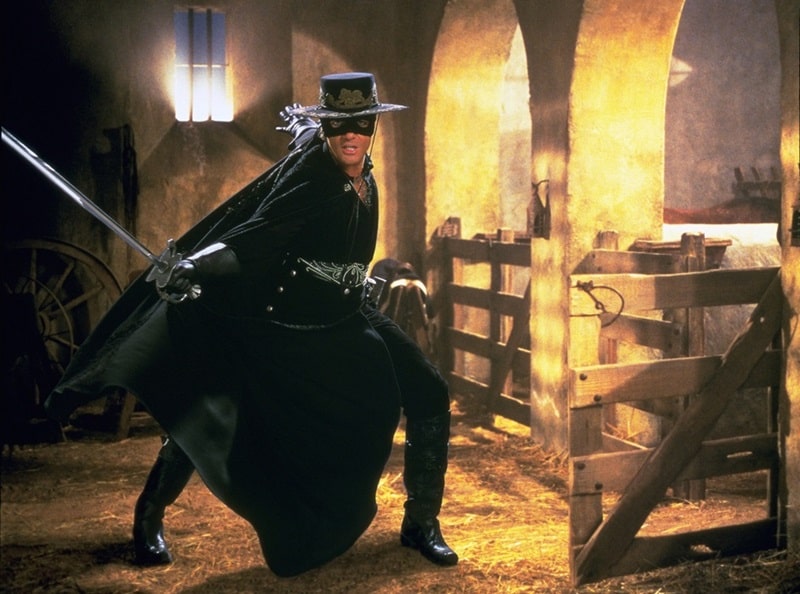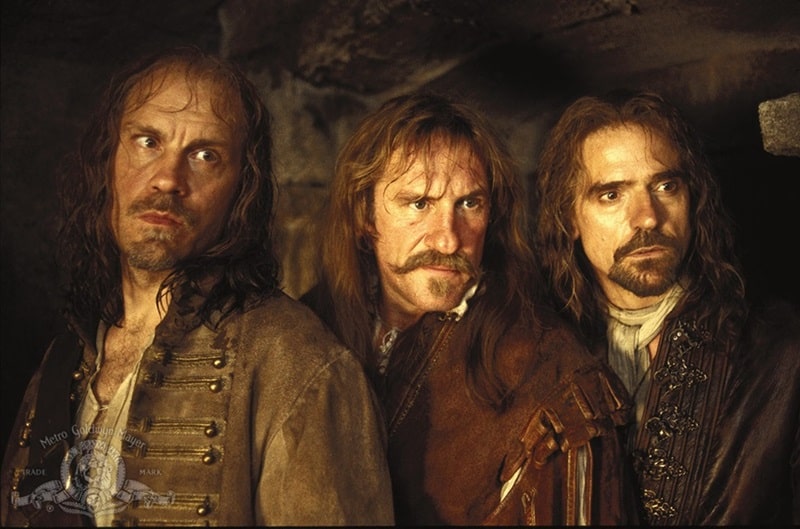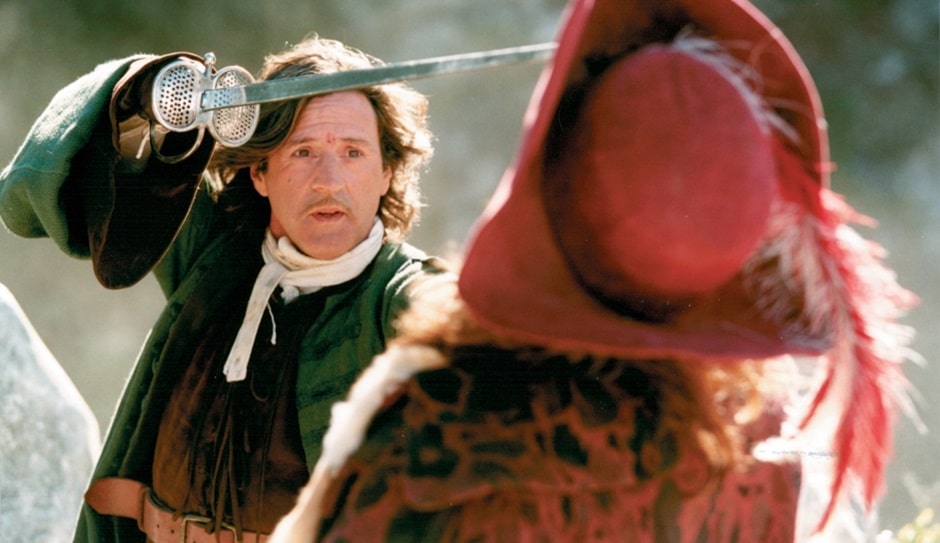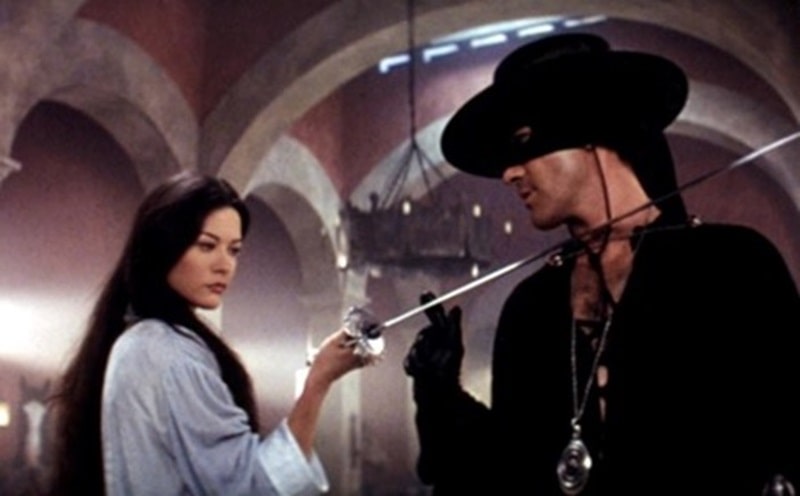Ellsworth’s Cinema of Swords: Consider the Rapier
The Mask of Zorro (USA, 1998)
Swashbucklers come in many forms and from many cultures, settling differences with their wicked nemeses with long blades of many shapes. Some leap aboard slashing with cutlasses; some coolly assume their stances with katanas at the ready, in one hand or two; some gallop to the charge, sabers waving; some wait for their attackers with claymores held high.
But I put it to you that there is no more iconic weapon for a swashbuckler to wield than the rapier. It’s a finesse weapon that relies as much on dexterity as strength, relatively light despite its three-foot blade, encouraging movement and rapid footwork. It hangs easily at the waist, from belt or baldric, an accent that adds martial flair to every bold outfit, and it looks as good on a woman as it does on a man. And crucially, it has a point but no edge, so it’s no battlefield weapon — its only function is to settle personal conflicts between antagonists with precision, by means of a thrust to wound or to kill.
The rapier is the weapon of choice of the heroes in all three of the movies from the late ‘90s we’re considering this time around: in the global hit that should have been a flop, in the critical darling that should have been a hit, and in the triumph that was both. Keep your knees flexed, your wrist loose, and don’t grip the hilt too tightly.
The Man in the Iron Mask (1998)
Rating: ***
Origin: United States, 1998
Director: Randall Wallace
Source: MGM DVD
Writer Randall Wallace’s first screenplay was Braveheart (1995), a worldwide mega-hit. Wallace was ambitious to produce and direct as well as write and used his Braveheart clout to swing all three roles on another historical adventure, an adaptation of Alexandre Dumas’ Man in the Iron Mask (1850), the final tale of musketeers d’Artagnan, Athos, Porthos, and Aramis, set during the reign of King Louis XIV. The classic story tells the tale of Louis’ twin brother, Philippe, and an attempt by some of the musketeers to replace the tyrannical Louis with his twin, who is imprisoned in a brutal iron mask so no one can recognize his resemblance to the king.
Dumas’ novel requires considerable revision for adaptation to a feature film, and purely from a plot standpoint, Wallace’s version is probably the best put on the screen to date. Unfortunately, its cinematic execution is weak, with inconsistent tone, writing, and direction, miscast roles, and some melodrama that’s so heavy-handed it verges on the ridiculous. And that’s a shame, because there’s a lot to like here, and this production could have been a winner if handled by a veteran director with a sense of restraint.
For example, some of the casting is spot-on: Gabriel Byrne as d’Artagnan and Jeremy Irons as Aramis capture those classic characters perfectly, and Anne Parillaud gives an affecting performance as Queen Mother Anne of Austria. Gerard Depardieu would have made a great Porthos if Wallace had written a great Porthos, but unfortunately, he trivialized the character into a mere buffoon and Depardieu’s talents are wasted. Casting John Malkovich as the dour Athos is probably a mistake, but it’s at least an interesting mistake, and Malkovich does well with what he’s given. Alas, the camaraderie between these musketeers feels forced and flat, a major opportunity lost given the stature of these actors.
The biggest problem is the critical error of casting the young Leonardo DiCaprio in the double role of the naughty Louis and the nice Philippe. His California accent and affect are wildly out of place here, and though he’s convincing as Philippe, making puppy-dog eyes at all the women, as nasty Louis his heart clearly isn’t in it, and at this point in his career (right after Titanic) he hasn’t got the acting chops to carry it off.
The film’s pacing is all over the place, and the first two-thirds of this rather long movie frequently just drag. The climactic scenes are kicked off by a spectacular masquerade ball — and in this genre, a masquerade ball is never wrong — after which the story picks up the pace and the end makes a solid landing.
For a musketeers movie, Iron Mask is unusually talky, and there’s a surprising lack of swordplay before the final confrontations. What swordplay there is, however, is handled by the great fight director Bill Hobbs, so it’s solid, except for one quite unbelievable bit just before the climax that’s clearly in there because Wallace thought it would make a badass, heroic scene. (It doesn’t.)
The excellent costumes, scenic and well-chosen French locations, and solid soundtrack are all nice to have, but they can’t save this Iron Mask from a weak script and tepid direction. Watch it once for Irons, Byrne, and Parillaud, and then file it away and forget about it.
On Guard (or Le Bossu)
Rating: *****
Origin: France/Italy, 1997
Director: Philippe de Broca
Source: Pathé DVD
Paul Féval, père (1816-1887) was one of the greatest genre fiction authors of 19th-century France, writing detective stories before Doyle and vampire stories before Stoker, but perhaps his most popular and enduring novel is Le Bossu, or The Hunchback (1857), a swashbuckler nearly as beloved as Dumas’ Three Musketeers or Count of Monte Cristo. It’s been brought to the screen a half dozen times in France, but never more effectively than this adaptation.
On Guard is superb; its first 45 minutes are near-perfect, encapsulating everything you want from a swashbuckling film. The rest of the movie is fine as well, just not as tightly paced as its first act, since it must cover a period of years as one of the main characters matures to an adult. As is traditional with old-school cape-and-sword melodramas, this is one plot-heavy beast, but I’ll try to sketch in the outlines to convey its classic elements.
In Paris in 1700, Lagardère (Daniel Auteuil), a charming and talented young sellsword of no birth or breeding, has managed to attach himself to the noble household of the Duke of Nevers (Vincent Pérez). When Nevers learns that his lover Blanche de Caylus (Claire Nebout) has borne him a child in her remote mountain domain, he sets off to marry her and adopt the babe — but as this would make Nevers’ jealous younger brother Gonzague (Fabrice Luchini) no longer Nevers’ heir, Gonzague decides that both his brother and his child must die.
An assassination attempt in Paris by a team of five shows how brilliant a swordsman Nevers is when he kills them all, and with the threat now apparent, he engages Lagardère to accompany him as his bodyguard.
There are several other attempts to kill Nevers on the journey, so the duke teaches Lagardère his secret sword attack (a staple of the genre), a deadly combination called the Nevers Thrust that ends with a lethal stab between the opponent’s eyes. The pair reach Caylus and Nevers marries Blanche, but then Gonzague and his killers arrive and slay the entire wedding party. However, after wounding Gonzague on the hand (“So I’ll know you again”), Lagardère escapes with the baby, Aurore de Nevers, and the pair hide among a troupe of traveling entertainers.
The above is the near-perfect part. Then the movie slows as Lagardère raises Aurore (Marie Gillain) among the acting troupe as his own daughter, teaching her what skills he can, including the Nevers Thrust, without revealing her true background. But in Paris again, when Aurore is seventeen, Gonzague accidentally learns that his niece (and true heir to his fortune) is still alive, so he unleashes his assassins to kill her and Lagardère. The latter hides Aurore among Paris’ criminal class, and then intrigues to regain his foster daughter her inheritance, assuming the guise of a wily hunchback who gradually leads Gonzague into a trap that will expose his villainy.
And this brings us to the creepy bit that’s tough for a modern audience to face, wherein Aurore, after learning that Lagardère isn’t actually her father, reveals that she loves him romantically and wants to be his wife despite their age difference and, er, former relationship. Ew.
But if you can get past that, On Guard is a must-watch: the performances are all great, the direction is nearly flawless, the swordplay is exciting and persuasive, the scenery is magnificent, the costumes and sets are splendid, and the musical score is jaunty and period-appropriate. And its signature line, “If you don’t come for Lagardère, Lagardère will come for you,” is nearly as well known in France as, “All for one and one for all.” Classic stuff.
The Mask of Zorro
Rating: *****
Origin: USA, 1998
Director: Martin Campbell
Source: TriStar DVD
This is a top-notch swashbuckler, very nearly a must-watch. It’s a sequel of sorts to the usual Zorro story, a passing of the hero’s mask to a new generation. It’s also a Stephen Spielberg production, and that director’s signature overwrought bloat nearly sinks the ending.
But the beginning is sublime. The ten-minute sequence of the original Zorro’s final exploit, saving three unjustly condemned men from the scaffold during Mexico’s revolution against Spain in 1821, perfectly captures what makes the dashing black-clad hero of the people so appealing, while sewing the seeds of the story to follow. As Zorro thwarts his nemesis, Don Rafael Montero (Stuart Wilson), the Governor of California, his swordplay and acrobatics are watched with worshipful eyes by two young peasant brothers, Joaquin and Alejandro.
But the sequel to this triumph is tragedy, as Montero, having deduced Zorro’s secret identity as Diego de La Vega (Anthony Hopkins), brings troops to Diego’s mansion to arrest him — and in the course of the arrest Diego’s wife is killed. As Diego is dragged off to prison, Montero, who had desired Diego’s wife, abducts his infant daughter Elena to raise as his own.
Cut to twenty years later: the young brothers, Alejandro and Joaquin Murrieta (the latter based on a legendary Gold Rush-era outlaw hero), are bandits in Upper California. When Joaquin is killed by the (quasi-historical) Texan cavalry officer Harrison Love (Matt Letscher), Alejandro (Antonio Banderas) swears to avenge him.
Meanwhile, Montero returns from Spain with big plans, so the aging Diego escapes from prison to enact his own revenge — which he aborts when he sees that Montero has brought his now-adult daughter Elena with him (Catherine Zeta-Jones, radiant). Diego encounters the furious but ineffectual Alejandro, sees his potential, and takes him on as his protégé, promising to train him to complete his vengeance on Montero’s aide, Captain Love — and enact Zorro’s own revenge in the process.
That setup concludes the first hour of the film, and the second hour is nearly all well-paced action and intrigue, as the new Zorro trains in both fencing and courtly etiquette, while conducting a burgeoning romance with the hot-blooded Elena. The brooding Banderas and smoldering Zeta-Jones have real onscreen chemistry, dancing and fencing with both words and blades. Anthony Hopkins as the embittered elder Zorro is charismatic while exuding a dark, almost sociopathic edge to his heroism. (Let’s not forget that Zorro was the main inspiration for Batman.) The villains are adequate, but they’re mainly here as foils for the three principals.
The fencing is superb, the pinnacle of renowned swordmaster Bob Anderson’s distinguished career: he trained the leading actors in swordplay for ten hours a day for two months, and it shows. The film was shot in Mexico and looks great, the vivid costumes are a bit theatrical but mostly period-accurate, and the script by Ted Elliott and Terry Rossio is lean and effective. The rousing, Spanish-infused musical score by James Horner is one of his finest.
The direction by Martin Campbell (GoldenEye, Casino Royale) is mostly solid and tight, until it goes off the rails in the aforementioned overwrought final scene, set in a slave-labor gold mine that looks like it was built by unhinged video game level designers and that you just know is going to meet its end in a three-minute fiery explosion sequence. So predictable.
It’s the only major misstep in this otherwise excellent film, and it’s a shame that it comes at the end because it leaves you with a sour taste in your mouth. Fortunately, there’s an easy solution: just watch those first ten minutes over again and you’ll go away happy.
Where can I watch these movies? I’m glad you asked! Many movies and TV shows are available on disk in DVD or Blu-ray formats, but nowadays we live in a new world of streaming services, more every month it seems. However, it can be hard to find what content will stream in your location, since the market is evolving and global services are a patchwork quilt of rights and availability. I recommend JustWatch.com, a search engine that scans streaming services to find the title of your choice. Give it a try. And if you have a better alternative, let us know.
Previous installments in the Cinema of Swords include:
The Barbarian Boom, Part 7
Avenging Women
Mondo Mifune
Near Misses in the Near East
Banditti!
Zatoichi at Large
Invitation to a Keelhauling
Sequel Debacle
Deuces Wild
Beware of Greeks
Peak ‘90s Wuxia
Ashes of Time
LAWRENCE ELLSWORTH is busily promoting the Cinema of Swords compilation from Applause Books that was born right here at Black Gate! The volume out now covers swordplay movies up through the ‘80s, but Ellsworth is continuing with new material for a Volume Two and is now working his way up through the 1990s. These later reviews are being published weekly on his new Cinema of Swords Substack blog, at cinemaofswords.substack.com.
Meanwhile, Ellsworth soldiers on in his mega-project of editing and translating new, contemporary English editions of all the works in Alexandre Dumas’s Musketeers Cycle; the sixth volume, Court of Daggers, is available now as an ebook or trade paperback from Amazon, while the seventh, Devil’s Dance, is being published in weekly installments at musketeerscycle.substack.com. His website is swashbucklingadventure.net. Check them out!
(Ellsworth’s secret identity is game designer LAWRENCE SCHICK, who’s been designing role-playing games since the 1970s. He now lives in Dublin, Ireland, and is Principal Narrative Designer for the Dungeons & Dragons videogame Baldur’s Gate 3.)




I’m not sure about the designation of three-foot blades as rapiers. GURPS Martial Arts, in its essays on fencing styles, refers to the use of such weapons as “smallsword fencing,” and uses “rapier” for longer, somewhat less conveniently carried weapons. Wikipedia articles give 24-31 inches as the length for smallswords, and 41-51 inches for rapiers (or “espadas roperas,” which they say means swords that are worn as part of regular clothing); their article on SMALLSWORD mentions a few that are as long as 39 inches. Zorro may well have carried a three-foot blade, giving the historical period of his adventures; d’Artagnan would probably have carried one closer to four feet. At least if my historical references are right; I haven’t researched this in depth, so I can’t independently certify their conclusions.
I certainly share your appreciation for The Mask of Zorro, a wonderful treatment of the theme. I’m sorry to say that I found its sequel, The Legend of Zorro, a real letdown that I have no interest in seeing again; even Banderas and Zeta-Jones couldn’t give it the same magic.
On Guard is my all-time favorite swashbuckler, bar none.
Mask of Zorro is also absolutely first-rate, well, aside from the issues with the ending. Shame about the sequel.
Another Ellsworth’s Cinema of Swords? Magnificent!
Ah, but it is the epee that is all point and no edge; the rapier is a cut-and-thrust weapon, as clearly displayed in the first and third pictures in this post. This doesn’t mean that a rapier couldn’t be a precision instrument of both attack and defense. I’ve held rapiers that were balanced so the center of gravity was right at the fingertips of the wielder. In the hands of a master, such a weapon would be truly formidable.
This is the second post I’ve seen in the past week that has sung the praises of On Guard! Now, I MUST SEE IT!